By P.J. Gladnick, Newsbusters
How embarrassing is it when you produce a horror movie based on global warming and when the time comes to release it, the planet is experiencing some of the coldest weather in decades? Such is the case with The Thaw starring Val Kilmer. Filmed in Canada last summer, it should be ready for release by now but even though the trailer has been produced, no specific release date has been announced.
Perhaps the producers realize how much of a laughingstock this movie would become if a movie based on the premise of global warming were released when their potential audience is freezing. Here is a description of “The Thaw” from Dread Central:
The Thaw will be produced by Anagram Pictures, the same team behind Andrew Currie’s badass debut Fido, with directing duties being handled by Mark A. Lewis. The story is about a group of ecological students who discover that a prehistoric parasite has come back to life after a woolly mammoth is defrosted and their race to stop the bug from infecting the entire world, even as they themselves fall victim to it.
We learned this week that The Thaw is finally getting ready to shoot in mid-June and that Val Kilmer (yes, that Val Kilmer) and Superbad’s Martha McIsaac have both signed on to the film! This brings The Thaw to a whole new level of respectability since you don’t attract that kind of talent with some throwaway script. “I think ultimately where this story comes from is the idea or, more accurately, the feeling of vulnerability,” Lewis told me during a recent e-mail conversation about the origins of The Thaw. “The discussion eventually evolved into one about the vulnerability of our species and how we’re about to experience the wrath of Mother Nature as a result of global warming. Remaining faithful to our inspiration [an experience Thaw’s co-writer’s girlfriend had with bed bugs], we chose to make Mother Nature’s device the most hideous parasite we could imagine.”
Perhaps Lewis should drop “The Thaw” title and rename it, “Attack of the Mutant Bed Bugs!” More about the hideous wooly mammoth parasite released by global warming flick:Don’t worry, though, The Thaw won’ be a preachy movie about how we’e facing the End of Days or anything. “ don’t consider it my job to tell people about how or why we’re f---ing up the world,"Lewis continues. “The older I get, the more vulnerable I see people are (as individuals and communities). Global warming is a very scary part of our place in time on this revolving rock in the middle of God knows where. I consider it my job to translate, into a story, the emotions (in particular the fear) I’m experiencing around an issue that is extremely interesting to me. Hopefully people will find the result enjoyable, relatable, and perhaps even cathartic.”
So far it sounds like we’re in pretty good hands for this one. Nothing like a good monster movie to point out just how weak humans can be in the face of Mother Nature. Keep it here for more updates on The Thaw as the film nears its production start date! And your humble correspondent would like to point out just how ridiculous film producers trying to promote a PC global warming message can be made to appear in the face of Mother Nature which is why the they seem to be embarrassed to release “The Thaw” in the midst of record low temperatures. However, perhaps “The Thaw” can still be salvaged. Just rename it “The Guffaw” and edit in Tom Servo and Crow T. Robot from Mystery Science Theater 3000 to make snarky comments about the defrosted mammoth and the rest of the movie. Such a move could unfreeze the box office receipts (if “The Thaw” is ever released) and turn this movie into a campy cult classic. Read more here.
Rod Nickel, The StarPhoenix
How’s this for cold comfort? Saskatoon’s deep freeze is likely the longest streak of low temperatures below -25 C that has numbed this city since record-keeping began in 1892. The 24-day streak started cruelly Dec. 13 after relatively mild temperatures and continued at least through Monday, said David Phillips, Environment Canada’s senior climatologist. “That’s the thing that’s brutal,” Phillips said from Toronto, where he was enjoying a temperature of -4. “We can all handle a few (cold) days. It’s the long haul that wears you down.
“It’s really a shocker, the duration of the cold.” Phillips said he couldn’t find a longer cold snap in Saskatoon’s recorded weather history during a look through the records Monday. Even during the infamous January of 1950, when temperatures hit -46 and -45 (not counting any wind chill), the cold streak of -25 or lower lasted “only” 21 days. The first two mild weeks of December kept the month from being Saskatoon’s coldest ever. It still averaged -20.6, the sixth-coldest December on record and the most frigid since 1983.
Prince Albert was slightly colder in December, with an average temperature of -21.4, while Regina registered -18. Neither of those burgs have suffered a -25 streak approaching Saskatoon’s, Phillips said. The normal average temperature for Saskatoon in December is -14.3. The historic streak could end today. Environment Canada was forecasting a low of -23 for today, before another drop Wednesday.
There’s no good news on the horizon. January is expected to be colder than its normal mean temperature of -17, said Environment Canada meteorologist Bob Cormier. The three-month period of January through March is also expected to be colder than normal, he said. The frigid temperatures and the bad timing of the New Year’s Eve snowstorm has left city snow crews well behind schedule. As of Monday, snowplows still hadn’t touched almost one-third of the priority streets, which range from arteries such as Circle Drive and Eighth Street to bus routes and minor collector streets. The major arteries have been cleared once, but may need a second pass, said Gaston Gourdeau, manager of the city’s public works branch. Ninety per cent of bus routes are cleared, but many minor collector streets still haven’t seen a snowplow.
“We’re looking forward to warmer temperatures,” Gourdeau said. “It’s been tough for everybody.” The New Year’s Eve storm was a double-whammy for snowplow operators. Many city staff were on holidays. Hydraulic parts of heavy equipment respond more slowly, like everything else, in the cold, forcing crews to get less done than they normally would. Gourdeau predicts snow crews will be in some neighbourhoods clearing out trouble spots by the end of the week. He said he decided against implementing a street parking ban to speed up snow clearing for two reasons. The city hasn’t had the staff to guarantee cleanup within 72 hours until this week. In frigid weather, it’s also difficult to ask residents to move cars off the street to spots where plug-ins may be unavailable, he said.
By Nawara Fattahova, Staff Writer Kuwait Times
The extremely cold weather continues to persist, and people can expect historically cold temperatures this season. Yesterday, the temperature reached five degrees below zero at Salmi and Bubyan Island. The temperature at Mina Abdullah reached minus 2 degree. People should be careful these days. “The very cold weather will remain this month, and people should stay at home as much as possible. If they go out, they should wear thermal innerwear to protect themselves from the wind and they should also cover their heads and faces if possible as the wind may carry viruses and bacteria that may be in the air,” said meteorologist Eisa Ramadan.
The low temperatures have also damaged local agricultural products. “It hasn’t rained in a few months and the land is dry. We are now facing even more problems as the temperature dipped below zero, which caused the destruction of about 80 percent of the agricultural production at Wafra and Abdali farms. Tomato, potato, green capsicum, egg plant, zucchini and beans were most affected by the weather. Also, 50 percent of crops grown in green houses were also destroyed,” said Mohammed, owner of one of the farms supplying the local market.
The prices of vegetables and fruits are expected to increase as there is a shortage in local production. “Still, the shortage is not so noticeable today, but we may notice it in the coming days. We are importing from other Arab countries anyway, but now we may increase the imported quantity,” said Hasan, an employee at the Andalus Cooperative Society.
Extreme temperature changes around the world have been commonplace for many years. “For instance, the heavy rains that took place last April here in Kuwait were caused by very strong winds that reached the power of hurricanes. Storms of that nature have not been seen in Kuwait for more than ten years. Also, Saudi Arabia witnessed heavy rains two months ago, and now it’s completely dry. The greenhouse effect, which can be blamed on modern industry, is responsible for these changes, and this problem will continue to develop in the coming years,” Eisa Ramadan said.
Many people camping in the desert suffered from some of the coldest weather in Kuwait. The temperature was at zero or below in most desert areas. “I went last night with my friends to our camp in the desert, but I couldn’t stay overnight as the weather was freezing. I think I won’t be visiting the camp much until the weather gets a little warmer,” said Waleed, a 25-year-old Kuwaiti. Ramadan also warned people to avoid sea trips at this time and said they were dangerous. “People must take the warning of meteorologists seriously as it may save their lives,” he said. Read more here.
By Steve McIntyre, Climate Audit
Obviously it’s impossible to avoid the old chestnuts on our TV sets these days. I saw the original version of Miracle on 34th St for the umpteenth time the other day, noticing something for the first time that is a sign of the times. The judge’s political handler, advising him of the political risks of the case, warned him that a decision against Kris Kringle would draw the ire of toy-makers, all unionized and all voters. How quaint.
It’s also impossible to avoid the snow. We got hit with another snow storm yesterday and, for the first time in my life, I was pondering whether I should be thinking about planning my snow banks so that I’d have a place for the snow later in the season. (Through my life, it’s never been an issue in Toronto, we don’t get that much snow as we’re in a bit of a shadow and what we get tends to come and go.) But last year we had snow banks into April and it became hard to figure out where to put the snow.
While thinking about this, I pondered about how Al Gore saved Christmas for us in Toronto, a story that’s been told before, but it’s the season for old stories.
Long ago (2006), in the bad old days before IPCC AR4, Toronto got its lowest snowfall in a century. Lake level declines were sure to follow. Would water supplies for lattes be threatened? Even the unthinkable now seemed possible and even likely.
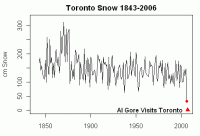
Nobody knew what do. Except for one little girl. (Hey, it’s a story.) She wrote to a famous ju-ju man in the South asking him to come north and cast a magic spell and make the snow return.
The ju-ju man heard the plea of the little girl. He quickly decided that the situation was far worse than even the little girl thought. This needed his most powerful magic and, so in 2007, he visited Toronto not just once, not just twice but three times.
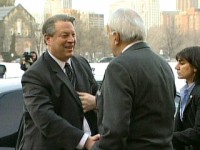
The magic worked! Soon Toronto was covered up in winter snow. The ju-ju man could only save part of the 2007 winter, but by 2008, his magic was in full force. Yesterday’s snow made 2008 snowfall the highest since 1883, with a few days still on the clock.
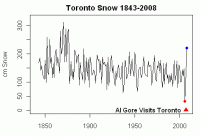
And it was all due to that one little girl.
As for me, my arms ache from shoveling snow. I think that the ju-ju man might overdid his spell a little. I’d have been OK with just one incantation. See post and comments here.
By Jo Macfarlane
Melting icebergs, so long the iconic image of global warming, are triggering a natural process that could delay or even end climate change, British scientists have found. A team working on board the Royal Navy’s HMS Endurance off the coast of Antarctica have discovered tiny particles of iron are released into the sea as the ice melts. The iron feeds algae, which blooms and sucks up damaging carbon dioxide (CO2), then sinks, locking away the harmful greenhouse gas for hundreds of years.

See larger image here.
British scientists have discovered that green algae could bury CO2 omissions at the bottom of the ocean. The team think the process could hold the key to staving off globally rising temperatures. Lead researcher Professor Rob Raiswell, from Leeds University, said: “The Earth itself seems to want to save us.” As a result of the findings, a ground-breaking experiment will be held this month off the British island of South Georgia, 800 miles south east of the Falklands. It will see if the phenomenon could be harnessed to contain rising carbon emissions.
Researchers will use several tons of iron sulphate to create an artificial bloom of algae. But environmentalists had warned that to do so artificially might damage the planet’s fragile ecosystem. The patch will be so large it will be visible from space. Scientists already knew that releasing iron into the sea stimulates the growth of algae Last year, the UN banned iron fertilization in the Great Southern Ocean.
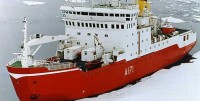
The team working on board HMS Endurance off the coast of Antartica have discovered tiny particles of iron are released into the sea as ice melts. However, the new findings show the mechanism has actually been operating naturally for millions of years within the isolated southern waters. And it has led to the researchers being granted permission by the UN to move ahead with the experiment. The scientist who will lead the next stage of the study, Professor Victor Smetacek, said: “The gas is sure to be out of the Earth’s atmosphere for several hundred years.” The aim is to discover whether artificially fertilising the area will create more algae in the Great Southern Ocean. That ocean is an untapped resource for soaking up CO2 because it doesn’t have much iron, unlike other seas. Read more here.
By Alan Siddons, edited by Hans Schreuder, Ilovemycarbondioxide.com
What animates global warming concerns more than anything is the imaginary greenhouse effect and an equally imaginary law of physics called “radiative equilibrium”. Energy out must equal energy in, this “law” says. Which does sound plausible on the face of it. In this view, however, if the light emitted by a heated object is suppressed in some way, its radiant energy will increase past the level of radiant input until it breaks through the barrier in obedience to this “law”.
This notion originates from a long-ago misconception about how glass greenhouses work, thus the family name this “effect” goes by. It was believed that glass blocked the passage of “dark radiation” (infrared) and kept storing energetic photons inside it. Once those photons had accumulated enough power to overcome the glass barrier, radiative equilibrium was achieved. So this is the scenario: sunlight enters, heat is generated and dark light is emitted. This dark light is amplified because of the blockage and finally exits at the same magnitude as the entering sunlight. But only after the light “trapped” inside has raised the greenhouse’s temperature. Since the barrier will keep raising the temperature until the barrier is broken, increasing the barrier’s strength will get you any amount of internal heat you want. (If only that were true).
It is 19th century poppycock. And here’s a telltale sign of it: Why do you always see a “layer of greenhouse gases” depicted overhead in illustrations about the “greenhouse effect”, when in fact these molecules are at their densest concentration right at your feet?
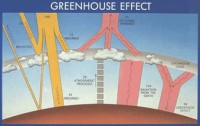
See larger image here
What these illustrations show you is the theory’s genetic lineage. That “layer of greenhouse gases” is merely a pane of greenhouse glass in another guise. There is no such “layer”. It started from a misconception about glass nearly 200 years ago and has stayed that way.
In reality, greenhouses merely suppress convective heat-loss, preventing the heated air from dissipating. It is air that’s trapped, not radiation; glass’s response to infrared (IR) has nothing to do with it. Clear plastic bags will do just as well or even panes of polished salt crystals, which don’t absorb IR at all. This is why polished salt crystals are used as windows in laboratory IR spectroscopy. Also, any infrared radiation absorbed by the glass is immediately re-radiated (scattered in all directions) by that glass, it does not constitute a radiative barrier.
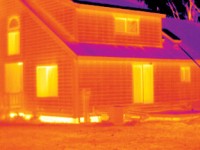
See larger image here
Thermal IR image of a house, showing IR radiation passing straight through the glass windows. This misconception is most famously known as the “settled science” - nothing is further from the truth though, but take a look at the praises heaped upon this “settled science”.
Water vapour - a “greenhouse gas”?
Dry air is cheaper to heat than moist air, thus clearly indicating that moist air gives up its retained heat more easily. This has been pointed out before and is the principle behind our bodies sweating to try and cool down. It’s a heat-loss mechanism because water vapor absorbs and then releases heat quite readily. Shifting this principle to an industrial context gives you steam engines, of course. Thinking that heat absorption implies insulative trapping is backwards thinking and quite breathtaking in its implications. Most of the warming in the climate models comes from the assumption that water vapor and precipitation increase as temperatures warm, a strong positive feedback. Water vapor is a far more important “greenhouse gas” than CO2. However, that assumption has been shown in observations and peer-reviewed research to be wrong, and in fact water vapor and precipitation act as a negative feedback that reduces any small “greenhouse warming” so incorrectly attributed to carbon dioxide.
So what does all this mean? Let’s put it together. It means that contrary to advertised, water vapor is a major “anti-greenhouse gas” - a term that has to be put in quotes because assuming that carbon dioxide is in any way a warming agent is also wrong, as is the whole “science of radiative forcing.”
Not only will the trace gases need more energy to reach the same temperature as the air that contains them, they will radiate it in all directions instantly and at the speed of light and thus increase the efficiency of the air mass in cooling it, not warming it, in line with the first and second laws of thermodynamics. There is also no need to provide a “blanket” to keep earth warm. The vacuum of space acts like the most perfect thermos flask. Space is not cold; it is empty, void of matter, and thus has no temperature. Read more here. Also see this analysis by Alan of what a candle teaches about heat transfer.
See also this Telegraph story where scientists suggest CO2 increase may lead to more cooling.
By Paul Dreissen
There is no such thing as “clean coal,” environmentalists insist. Burning coal to generate electricity emits soot particles that cause respiratory problems, lung cancer and heart disease, killing 24,000 Americans annually. It’s the kind of claim that eco-activist Bruce Hamilton says “builds the Sierra Club,” by generating cash and lobbying clout for his and similar groups.
It’s also disingenuous, unethical and harmful. Since 1970, unhealthy power plant pollutants have been reduced by almost 95% per unit of energy produced. Particulate emissions (soot) decreased 90% below 1970 levels, even as coal use tripled, and new technologies and regulations will nearly eliminate most coal-related pollution by 2020, notes air quality expert Joel Schwartz.
Moreover, the vast bulk of modern power plant particulates are ammonium sulfate and ammonium nitrate. “Neither substance is harmful, even at levels tens of times greater than are ever found in the air Americans breathe,” Schwartz says. The alleged death toll is based on speculative links between pollution and disease, and unwarranted extrapolations from responsible estimates to levels that grab headlines and prompt contributions.
Coal helps keep American homes, businesses, factories, airports, schools and hospitals humming, and provides myriad benefits that never get mentioned by anti-coal factions. Even if we accept these groups’ assertions as fact, the benefits of coal should be considered in any policy debate - just as we acknowledge (and strive to reduce) motor vehicle deaths, but recognize the value of transporting people, products and produce.
Coal generates half of all US electricity, and 60-98% in twenty-two states, according to the Energy Information Administration. Modern, state-of-the-art, low-pollution coal-fired generators have replaced both antiquated power plants and monstrous industrial furnaces that were the backbone of our nation’s steel-making and industrial might just two generations ago. They improve and save millions of lives.
Imposing excessive new regulations, or closing coal-fired power plants, would produce few health or environmental benefits. But it would exact huge costs on society - and bring factories, offices and economies to a screeching halt in states that are 80-98% dependent on coal: Indiana, Kentucky, Missouri, North Dakota, Ohio, Utah, West Virginia and Wyoming.
Coal’s reliable, affordable electricity creates millions of high-paying jobs, and thus provides health insurance, rent and mortgage money, nutrition, clothing and retirement benefits for countless families. It keeps people warm (and alive) on freezing nights, and comfortable during summer heat waves like the 2003 scorcher that killed 15,000 elderly French citizens who didn’t have air-conditioning. Read more here.
By UK Telegraph Staff
Temperatures are falling, not rising
As Christopher Booker says in his review of 2008, temperatures have been dropping in a wholly unpredicted way over the past year. Last winter, the northern hemisphere saw its greatest snow cover since 1966, which in the northern US states and Canada was dubbed the “winter from hell”. This winter looks set to be even worse.
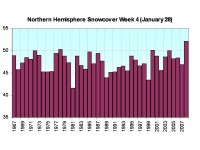
See larger image here
The earth was hotter 1,000 years ago
Evidence from all over the world indicates that the earth was hotter 1,000 years ago than it is today. Research shows that temperatures were higher in what is known as the Mediaeval Warming period than they were in the 1990s.
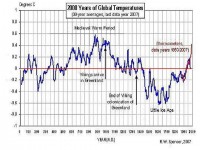
See larger image here
The earth’s surface temperature is not at record levels
According to Nasa’s Goddard Institute for Space Studies analysis of surface air temperature measurements, the meteorological December 2007 to November 2008 was the coolest year since 2000. Their data has also shown that the hottest decade of the 20th century was not the 1990s but the 1930s.
Ice is not disappearing
Arctic website Crysophere Today reported that Arctic ice volume was 500,000 sq km greater than this time last year. Additionally, Antarctic sea-ice this year reached its highest level since satellite records began in 1979. Polar bear numbers are also at record levels.
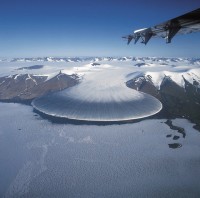
Elephant Foot glacier, Greenland. See larger image here
Himalayan glaciers
A report by the UN Environment Program this year claimed that the cause of melting glaciers in the Himalayas was not global warming but the local warming effect of a vast “atmospheric brown cloud” over that region, made up of soot particles from Asia’s dramatically increased burning of fossil fuels and deforestation.
Temperatures are still dropping
Nasa satellite readings on global temperatures from the University of Alabama show that August was the fourth month this year when temperatures fell below their 30-year average, ie since satellite records began. November 2008 in the USA was only the 39th warmest since records began 113 years ago.
See this story in a newspaper that with the exception of Christopher Booker’s stories, tends to alarmism. An encouraging sign.


